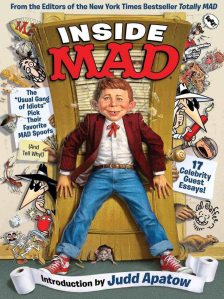 Inside MAD is a beautiful hardback book, a wonderful treasure trove of the best of MAD; inside its pages, you’ll find prime examples of the best of “the usual gang of idiots,” dozens of the funniest writers and artists of their day, all at the top of their game.
Inside MAD is a beautiful hardback book, a wonderful treasure trove of the best of MAD; inside its pages, you’ll find prime examples of the best of “the usual gang of idiots,” dozens of the funniest writers and artists of their day, all at the top of their game.
MAD contributors, including Sergio Aragonés, Tom Bunk, Tim Carvell, Paul Coker, Jack Davis, Dick DeBartolo, Desmond Devlin, Mort Drucker, Mark Fredrickson, Drew Friedman, Frank Jacobs, Al Jaffee, Peter Kuper, Tom Richmond and many more, have each selected a favorite article from MAD‘s 61-year history and written an essay explaining why it was chosen or what significance it has for them. In addition to “the usual gang of idiots,” celebrities Roseanne Barr, Ken Burns, Dane Cook, Paul Feig, Whoopi Goldberg, Harry Hamlin, Tony Hawk, Ice-T, Penn Jillette, George Lopez, David Lynch, Todd McFarlane, Jeff Probst, John Slattery, John Stamos, Pendleton Ward and Matthew Weiner all contributed essays of their own, each one accompanying a relevant article or feature from the magazine.
The centerpiece of the book, both literally and figuratively, is the fold-out poster in the middle; one side is a reproduction of the classic “op-art” Alfred E. Neuman poster, originally published in More Trash From MAD (1965) and never reprinted until now; on the opposite side is an all-new, specially-commissioned gatefold poster by Sergio Aragonés illustrating the history of the legendary MAD offices from the beginning as a comic book under Harvey Kurtzman to the present day. It’s a spectacular piece of work as only Sergio can do it.

Like a lot of ex-children, I can tell you exactly which issue of MAD was the first I ever read, and like most people, it came to me when I was about 10 years old. It was #121, cover-dated September 1968 but on sale in July. I was visiting my grandparents for the summer, and one of my uncles, seeing that I was a voracious reader and loved comics, picked up a copy for me. Woodstock was in the news, Hair was playing on Broadway, hippies were heading to Chicago to protest the Democratic National Convention, and I was only peripherally aware of any of those things. MAD had the Beatles on the cover, along with Mia Farrow and Maharishi Mahesh Yogi, with Alfred E. Neuman taking on the role of guru to them all. Looking at the cover just now, 45 years later, I finally got one of the jokes for the first time; the fake sanskrit lettering around the border never meant anything to me before. Hah!
This is the beauty of MAD; at age 10, you laugh at Spy Vs. Spy and Don Martin‘s hilarious sound effects; search out Sergio Aragonés’ brilliant little cartoons in the margins; you love the movie parodies, especially the fantastic caricatures by Mort Drucker, even though you never saw or heard of the movies. Years later, revisiting MAD as an adult, you’re struck by the subversive chutzpah of a parody of Valley of the Dolls in a magazine ostensibly for children, and impressed that somehow they get away with it and make it work for both audiences. MAD never wrote down to kids, but never went so far over their heads that it made no sense to them; instead, MAD included kids in the conversation.
When somebody says “MAD isn’t as good as it used to be,” what they really mean is “I’m not 11 anymore,” and that is MAD‘s crowning achievement; for over 60 years, it has been the magazine that lets children come to the grown-ups’ table. MAD speaks to kids about important social issues like media manipulation, celebrity worship, political corruption, and the pervasiveness of corporate marketing, in terms they can understand, with wit and satire, making kids feel sophisticated and mature because they can crack wise about the President or whatever the current controversy happens to be. They skewer the self-important, ridicule hypocrisy, and teach children to recognize baloney when they hear it. When I got to meet Al Jaffee in 2011, the first thing I did was thank him for teaching me how to be a smartass. There are three generations of people who owe at least some of their sensibilities to MAD.
Whether you are a life-long reader, or you haven’t looked at MAD since you were a kid, or you’ve never seen it at all, you should pick up Inside MAD; its influence on modern pop culture cannot be overstated. Inside MAD is from Time Home Entertainment Inc., and is on sale October 29, 2013 for $29.95 (Cheap!) at retailers nationwide and www.insidemad.com.


